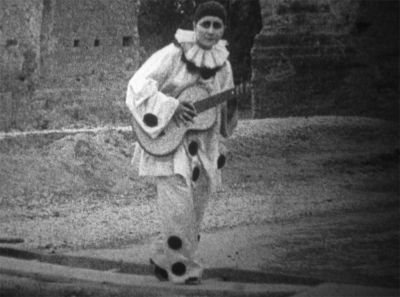
LE MIRACLE DES FLEURS/ IL DISINGANNO DI PIERROT
LE MIRACLE DES FLEURS
(Francia/1912) R.: René Leprince. D.: 15'
IL DISINGANNO DI PIERROT
(Italia/1915) R.: Ugo Falena. D.: 28'
Accompagnamento al piano di Stephen Horne
Come già i film-pantomima del Cinema Ritrovato 2011, questo programma è una pars pro toto del progetto complessivo irrealizzato "Le pantomime e i Pierrot nel cinema prima del 1920". Sarebbe una cosa grandiosa: avremmo modo di vedere i mimi Gaston Séverin e George Wague, film-pantomima come L'Enfant prodigue e Pierrot Assassin, come pure tanti cortometraggi con Pierrot, Colombine e Arlecchini... Una storia di lungo corso, che muove da Debureau intorno al 1830 e, passando per la Pierrot-mania ottocentesca in tutte le forme possibili di rappresentazione (canzoni, pittura, lirica), giunge fino al cinema di Pierrot, anche qui melanconico e lunare. E come nel caso della féerie, così anche il corpus dei film su Pierrot, che ancora attende uno studio sistematico, rappresenta da un lato il prezioso documento su un'arte scenica tramontata e, dall'altro, i suoi ultimi fuochi. Negli anni Dieci famose attrici interpretarono una dopo l'altra il ruolo di Pierrot en travesti. Una delle prime fu Stacia Napierkowska che, in quanto danzatrice, era particolarmente titolata a farlo (Le Miracle des fleurs, 1912). Le fecero seguito nel 1913 Francesca Bertini, nella versione cinematografica di Storia di un Pierrot (1897, "opera senza canto" di Pasquale Costa Mario), Sandrina Albertini-Bianchi (L'anello di Pierrot, 1917, Edoardo Bencivenga) e Diana Karenne (Pierrot, 1917, Diana Karenne, oggi perduto). Michel Carré portò sullo schermo la sua fortunata pièce L'Enfant prodigue del 1890 (di cui pare ci fossero una versione cantata e una muta) una prima volta nel 1907 (215 m, perduto), e poi di nuovo nel 1916, con Cécile Guyon come Pierrot fils (1500 m). Grazie alla Cinémathèque française, di Il disinganno di Pierrot (1915, ancora con "la bella Stasia"), possiamo mostrare una copia lavoro, un duplicato del negativo superstite. Mancano le didascalie dei sei tableaux, che sono riportate nel catalogo Pathé (Il primo amore / Nell'isola degli incanti / Le prime nuvole / Breve felicità / Triste ritorno / L'ultimo bacio) e la colorazione pochoir. In questo caso, però, il bianco e nero vale forse ad accentuare l'atmosfera metà Ottocento del film e la sua somiglianza con la fotografia delle origini. Che cosa impedisce la realizzazione di questo progetto da sogno sulle pantomime? La musica, o meglio: i costi che essa comporta. Questa forma d'arte dipende dall'integrazione di musica e rappresentazione visiva. Riuscire a trovare le partiture, riarrangiarle in vista dell'esecuzione di una piccola o grande orchestra, fare le prove... non c'è un limite massimo di spesa.
This programme represents (as did the mime films at last year's Cinema Ritrovato) an unrealised and wide-ranging project, 'Mime and Pierrot in pre-1920 Cinema'. It would be magnificent, with films featuring stage artists Gaston Séverin and Georges Wague, mime films such as L'Enfant prodigue and Pierrot assassin, as well as short films with Pierrots, Colombines and Harlequins. It is a long story, starting with Debureau, around 1830, and the 19th-century 'Pierrot mania' seen in every kind of performance and art, in song, painting and verse - right up to the cinema Pierrot, who was also lunaire and always associated with death. And, as in the féerie genre, we find in the corpus of Pierrot films (as yet never systematically researched) precious documents of a now-lost theatre art on the one hand and, on the other, its final blossoming. In the 1910s celebrated film actresses loved to play Pierrot en travesti: Napierkowska was one of the first and, as a dancer, was particularly well qualified for the role (Le Miracle des fleurs, 1912). She was followed in 1913 by Francesca Bertini in a film version of Storia di un Pierrot (1897), the opera senza canto by Pasquale Mario Costa, then Sandrina Albertini-Bianchi (L'Anello di Pierrot, 1917, Edoardo Bencivenga) and Diana Karenne (Pierrot, 1917, Diana Karenne, now lost). Michel Carré filmed his highly successful 1890 work L'Enfant prodigue once in 1907 (215m, lost) and again in 1916, with Cécile Guyon as Pierrot fils (1500m). Thanks to the Cinémathèque française, we can show the 'work print' of Il disinganno di Pierrot (1915), a duplicate from the surviving negative. This means that the intertitles (according to the Pathé catalogue: Le premier amour / Dans l'île des enchantements / Les premiers nuages / Brève félicité / Triste retour / Le dernier baiser) are missing, as is the stencil colouring. However, the black and white may enhance the romantic atmosphere of the film, giving it the distant stillness of very early photography. What is preventing this dream project from being put into action? The music. In this integrated art form, the overall effect arises out of the combination of music with visual spectacle. To find the scores, to arrange them for the surviving films, for a small or large orchestra, to rehearse... there is no upper limit to the costs.

Tariffe:

Numero posti: 174
Aria Condizionata
Accesso e servizi per disabili
Il nostro cinema aderisce al circuito CinemAmico: è possibile utilizzare l’applicazione MovieReading® per i film di cui è prevista audiodescrizione e/o sottotitolazione sull'applicazione.
Tel. 051 2195311











